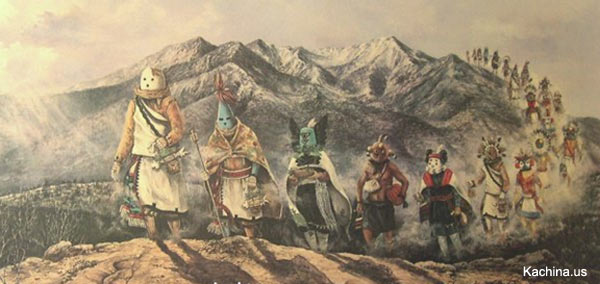The Gods of the Hopi and the dance of the Kachinas
The Hopi live, move, and have their being in religion. To them the unseen world is peopled with a host of beings, good and bad, and everything in nature has its being or spirit.
Just what kind of religion shall we call this of the Hopi? Seeing the importance of the sun in their rites, one is inclined to say Sun Worship; but clouds, rain, springs, streams enter into the idea, and we say Nature Worship. A study of the great Snake Cult suggests Snake Worship; but their reverence for and communion with the spirits of ancestors gives to this complex religious fabric of the Hopi a strong quality of Ancestor Worship. It is all this and more.
The surface of the earth is ruled by a mighty being whose sway extends to the underworld and over death, fire, and the fields. This is Masauwu, to whom many prayers are said. Then there is the Spider Woman or Earth Goddess, Spouse of the Sun and Mother of the Twin War Gods, prominent in all Hopi mythology. Apart from these and the deified powers of nature, there is another revered group, the Kachinas, spirits of ancestors and some other beings, with powers good and bad. These Kachinas are colorfully represented in the painted and befeathered dolls, in masks and ceremonies, and in the main are considered beneficent and are accordingly popular. They intercede with the spirits of the other world in behalf of their Hopi earth-relatives.

Drawings from an 1894 anthropology book of Kachina dolls (tihu-tui) representing kachinas, or spirits, made by the native Pueblo people of the Southwestern U.S.
Masked individuals represent their return to the land of the living from time to time in Kachina dances, beginning with the Soyaluna ceremony in December and ending with the Niman or Kachina Farewell ceremony in July.
Much of this sort of thing takes on a lighter, theatrical flavor amounting to a pageant of great fun and frolic. Dr. Hough says these are really the most characteristic ceremonies of the pueblos, musical, spectacular, delightfully entertaining, and they show the cheerful Hopi at his best—a true, spontaneous child of nature.
There are a great many of these Kachina dances through the winter and spring, their nature partly religious, partly social, for with the Hopi, religion and drama go hand in hand. Dr. Hough speaks appreciatively of these numerous occasions of wholesome merry-making, and says these things keep the Hopi out of mischief and give them a reputation for minding their own business, besides furnishing them with the best round of free theatrical entertainments enjoyed by any people in the world. Since every ceremony has its particular costumes, rituals, songs, there is plenty of variety in these matters and more detail of meaning than any outsider has ever fathomed.
The Niman, or farewell dance of the Kachinas, takes place in July. It is one of their big nine-day festivals, including secret rites in the kivas and a public dance at its close.

Kachina dancers, Shongopavi pueblo, Arizona, sometime before 1900
Messengers are sent on long journeys for sacred water, pine boughs, and other special objects for these rites. This is a home-coming festival and a Hopi will make every effort to get home to his own town for this event. On the ninth day there is a lovely pageant just before sunrise and another in the afternoon. No other ceremony shows such a gorgeous array of colourful masks and costumes. And it is a particularly happy day for the young folk, for the Kachinas bring great loads of corn, beans, and melons, and baskets of peaches, especially as gifts for the children; also new dolls and brightly painted bows and arrows are given them. The closing act of the drama is a grand procession carrying sacred offerings to a shrine outside the village.
This is the dance at which the brides of the year make their first public appearance; their snowy wedding blankets add a lovely touch to the colourful scene.
Featured image: Kachina March - John Steele (1921 - 1998). Photo credit: Kachina.us
‘Gods and Kachinas’ is a public domain article published in Lockett, H. G. (1933). The Unwritten Literature of the Hopi. Arizona: University of Arizona


















Comments
Kashinas dolls drawing ;
upper line ; God in the center with his 2 sons ?
down on the picture ; one yellow, brown, red or white skin peoples ?